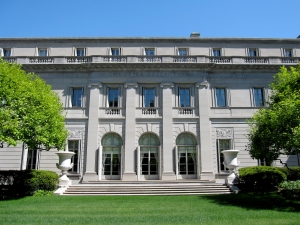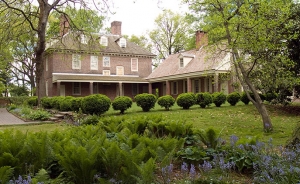|
Displaying items by tag: Decorative Arts
The unique atmosphere of The Frick Collection has as much to do with the decorative arts as with the old master paintings that line the museum's walls. Indeed the enamels, clocks and watches, furniture, gilt bronzes, porcelain, ceramics, silver, and textiles far exceed in number, and are the equal in quality, of the works on canvas and panel.
The institution announces the publication of the first handbook devoted to the decorative arts in the collection.
Coming up on June 22, Bonhams Los Angeles is holding a European Furniture and Decorative Arts auction featuring highlights from a myriad of noteworthy collections, including that of Casablanca director Michael Curtiz, and Rupert Murdoch – formerly from the collection of Dr. Jules C. Stein.
Leading the 539-lot sale is a pair of François Linke French gilt bronze mounted Vernis Martin decorated mahogany vitrines, circa 1900 (est. $60,000-80,000). It highlights a strong selection of Parisian furniture and decorative arts from the late 19th century including works by such makers as Linke, Beurdeley, Zwiener, Sormani, Durand, Barbedienne, Escalier de Cristal, Boudet and Christofle.
On July 9, Christie’s London will continue its tradition of French decorative arts sales with a “Taste of the Royal Court: Important French Furniture and Works of Art From A Private Collection.”
The sale comprises 22 lots of 18th century French decorative arts including an exquisite armchair made for Queen Marie Antoinette (estimate £300,000-500,000) and an extremely rare bureau plat by Charles Cressent (estimate £1-1.5million). The sale is expected to bring in over £6 million ($9.24 million).
In Ohio’s early years, clay deposits were discovered along a number of riverbanks and small-scale stoneware potteries sprang up to meet the utilitarian demands of a growing population. These potteries later took advantage of the state’s excellent location and the various transport routes...
To continue reading this article about Ohio decorative arts, visit InCollect.com.

When Henry Clay Frick set out to furnish his new residence at 1 East 70th Street, his intention was to replicate the grand houses of the greatest European collectors, who surrounded their Old Master paintings with exquisite furniture and decorative objects. With the assistance of the art dealer Sir Joseph Duveen, Frick quickly assembled an impressive collection of decorative arts, including vases, potpourris, jugs, and basins made at Sèvres, the preeminent eighteenth-century French porcelain manufactory. Many of these objects are featured in the upcoming exhibition "From Sèvres to Fifth Avenue," which presents a new perspective on the collection by exploring the role Sèvres porcelain played in eighteenth-century France, as well as during the American Gilded Age. While some of these striking objects are regularly displayed in the grand context of the Fragonard and Boucher Rooms, others have come out of a long period of storage for this presentation. These finely painted examples will be seen together in a new light in the Portico Gallery.
The Renwick Gallery, the Smithsonian Institution’s decorative arts and crafts museum in Washington, DC, is due to reopen to the public on November 13 after a two-year, $30m renovation. Built in 1859 across from the White House, the Renwick is the first American building designed specifically to showcase art.
The inaugural exhibition, “Wonder”, will take over the entire museum. The Renwick commissioned nine contemporary artists, including Chakaia Booker, Tara Donovan, Maya Lin and Leo Villareal, to create site-specific, room-size installations out of unorthodox materials such as insects, tires and glass marbles.

Decorative details by Lockwood de Forest, architectural woodwork by Stanford White, painted friezes by Francis D. Millet and George Yewell, stencil-work by Samuel Colman, embroideries by Candace Wheeler -- the Park Avenue Armory’s Veterans Room is a masterpiece of the American Aesthetic Movement -- an avant-garde style rooted in the belief that everything should be beautiful. Built in the late nineteenth century, the opulent space was designed and executed by Louis C. Tiffany, Associated Artists -- a cooperative firm of designers led by the visionary Louis Comfort Tiffany. The room is one of the few surviving spaces by Associated Artists, and one of only two interiors by Tiffany and White ever created -- the second one being the Armory’s library, which is located next door to the Veterans Room.
The Park Avenue Armory, which boasts an extraordinary ensemble of nineteenth-century period rooms, has announced that it will revitalize its Veterans Room as part of an ongoing, $200-million project that has helped turn its five-story landmark building...
To keep reading this article about the Park Avenue Armory's Veterans Room, which includes decorative elements by Lockwood de Forest, Stanford White, Candace Wheeler, and more, visit InCollect.com.

In conjunction with Stenton’s exhibition, LOGANIA: Stenton Collections Reassembled, Stenton has brought together known Logan family Queen Anne chairs and comparable examples from public and private collections. This lecture and workshop will provide a close study of chairs that may appear the same or very similar on the outside, but are structurally different on the inside. Why these differences? Where did they come from? What do they tell us about chair making in Colonial Philadelphia? Join us at Stenton on Friday April 17th for this special workshop exploring Queen Anne chairs and their construction. Workshop will be led by Laura Keim, Stenton’s Curator, and Philip Zimmerman, Scholar and Decorative Arts Consultant. Tickets are Required.
Ticket prices are $50 for General Admission, $45 for Friends of Stenton or NSCDA/PA members. Fee includes buffet lunch. Please email This email address is being protected from spambots. You need JavaScript enabled to view it. or call 215-329-7312 for more information or for reservations.

Fraktur—decorated Germanic manuscripts and printed documents—have long been admired as an extraordinarily vibrant and creative art form (Fig. 1). A European tradition brought to America by German-speaking immigrants, who began settling in southeastern Pennsylvania in 1683, fraktur are among the most distinctive and iconic forms of American folk art. The Philadelphia Museum of Art was one of the first major institutions to collect Pennsylvania German fraktur and decorative arts. In 1897, then-curator Edwin Atlee Barber acquired the museum’s first fraktur and, in 1929, the museum opened to the public the first period rooms of Pennsylvania German art. Many of the furnishings were donated by J. Stogdell Stokes, with additional furniture, ironwork, textiles, redware, and other objects acquired from Titus C. Geesey. The museum’s fraktur were never on par with the rest of the collection, but with the recent promised gift of nearly 250 fraktur from the collection of Joan and Victor Johnson (Fig. 2), the museum’s fraktur collection is now one of the finest in the country.
The Johnsons, Philadelphia natives, began collecting fraktur nearly sixty years ago, initially to help fill the walls of a historic farmhouse they bought and restored after their marriage in 1955. Joan, who studied contemporary art at Goucher College, loved the Bauhaus and planned to collect accordingly—but Victor, who worked in the computer industry, didn’t want to live with modern art.
Visit InCollect.com to read more about Pennsylvania German Fraktur.
A stunning presentation of American folk art made primarily in rural areas of New England, the Midwest, and the South between 1800 and 1925 opened at The Nelson-Atkins Museum of Art in Kansas City March 28. "A Shared Legacy: Folk Art in America" celebrates art rooted in personal and cultural identity and made by self-taught or minimally trained artists and artisans. Drawn from the prestigious collection of Barbara L. Gordon, "A Shared Legacy" highlights 63 outstanding examples of American folk art. Vivid portraits, still lifes, and landscapes, as well as distinctive examples of painted furniture from the German American community, carved boxes, sculpture and decorative arts of the highest quality offer an introduction to more than a century of America’s rich and diverse folk art traditions and exemplify the breadth of American creative expression.
|
|
|
|
|